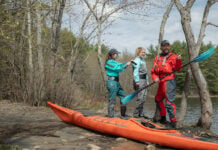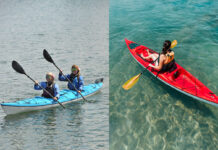You can’t be mentally prepared for a canoeing epic until you’ve got all the right gear together. The word “epic” can mean different things to different paddlers, but fortunately, aside from a couple of items, most of the packing list is remarkably similar whether you’re paddling away for a four-day weekend or for the summer.
Knowing what gear you need to be comfortable, happy and safe on the water can put your mind at ease. And while it may take a few trips to customize your kit to your liking, some necessities should be on everyone’s packing list. Here are 10 of those essentials for your next canoeing epic.
View this post on Instagram
Expedition Paddle
There’s a lot of thought that goes into choosing your daily power source. Durability is the most critical factor for expedition paddles. Match the blade to the route—if you are bouncing off rocks on a river, look for a burlier paddle design with a reinforced tip and maybe even a fiberglass-reinforced blade. The average tripper takes 25 strokes a minute, so weight quickly becomes a factor. The lighter the paddle, the easier it is on your body to paddle all day, but weight considerations are often secondary to durability in a remote location. Most expedition paddles are made of wood, but there are also options made in carbon and composite blends. Carbon fiber paddles are typically lighter than wood paddles, but also more rigid—which can be hard on joints over time. No matter what you choose as your primary paddle, remember always to pack a spare. Learn more about how to select the perfect paddle here.
View this post on Instagram
Barrels and Harness
Many trippers think barrels are the ultimate way to pack your gear on a canoe trip. Barrels typically come in 30- or 60-liter sizes, and if you’re on a canoe trip of any serious length you’ll want one. Closed properly, barrels are entirely waterproof—even if they end up in the water and are bashed around a bunch. While big PVC dry bags are a popular alternative to barrels for many trippers, many of these bags don’t remain bone dry inside during a prolonged swim. And it’s only a matter of time until someone—or something—pokes a hole in it.
Not only can you cram lots of gear inside a barrel, but it can protect delicate items, like the loaf of bread you’re saving for day eight. The barrel also gets bonus points for being relatively small-animal proof.
However, even with all those benefits stated, portaging a barrel sucks. If you’re going to do any portaging, you’ll need to put your barrel in a carrying harness. There are many harnesses on the market and it’s worth trying out your options with a packed barrel to get sizing and comfort right. Harnesses range from strictly utilitarian designs with webbing and a bit of padding to backpacker-inspired systems that are thoughtfully designed to help you cover miles in comfort. The most comfortable harnesses may cost you more than the barrel itself, but 10 steps into a three-mile portage all those pennies will feel like money well spent.
View this post on Instagram
In the old days, there was a single choice for navigation: a map and a compass. And today, if you know how to use them, that’s still all you need. Even for those who like to adopt new technologies, a map in a waterproof case is essential to have as a backup so if the batteries die in all your devices or they get waterlogged, you’re not up the creek. Nowadays, the number of electronic devices and gadgets that can keep you on track in the wilderness feels countless. The most affordable option might be downloading an offline mapping app, like Gaia (www.gaiagps.com), to turn your smartphone into a navigation and tracking tool, even in areas without cell phone signal. Or, you can invest in a GPS device. Be sure to look for one that is waterproof, reliable and durable, and get familiar with using it. For lengthy trips, you’ll also want to have some way to charge batteries or carry extra batteries. Whether you choose a time-honored method or a high tech one, be sure to practice using your navigation system before you go.
View this post on Instagram
Medical Kit
Don’t leave home without one. Trippers should always have a fully-stocked wilderness first-aid kit on hand, customized to match the length and hazards of your trip. At the minimum, every fully stocked first-aid kit needs to include items to manage bleeding, burns, wound care, musculoskeletal injuries, drugs to manage common ailments, and any prescription medications. A small reference guide is also valuable. A wilderness first aid course is an excellent investment for anyone spending time in remote areas.
The items included in a kit on an epic canoe trip are not fundamentally different than what a paddler would bring in a weekend first-aid kit, but you’ll likely want more of everything—especially of the most commonly used items, like BandAids and moleskin. Always replace what you take out. Check expiry dates on any medicine regularly and replace when needed. Discover the essentials for your own DIY first aid kit here.
View this post on Instagram
Safety Gear
Staying safe on the water is key to having a good time. The law often requires canoeists have a throw bag, a whistle and a PFD. Some regions require paddlers to have a flashlight, a reboarding device and a bilge pump. No matter what the law says you need, having the right equipment for any emergency will bring peace of mind and could save your life. Regardless of where you are paddling, an extra throw bag is always a good idea. For those paddling in whitewater, a helmet, river knife, and pin kit—and the knowledge to use it—are essential. Learn more about safety essentials here.
View this post on Instagram
In-Field Repair Tools & Materials
There’s an old saying, that if it moves and it shouldn’t, use duct tape. If it doesn’t move but should, use WD-40. While the WD may not come in handy on a canoe trip, a roll of good-quality duct tape almost certainly will. As will some zip ties, a good utility knife, and pliers. What you pack in your canoe trip toolbox depends on the tools you’re comfortable using, but something always seems to break on trip. Establishing a general repair kit if a great idea, and should include the items needed to fix a tear in the tent or a hole in an inflatable mattress, as well as the essentials for cleaning a stove. River trippers may opt for some spare bolts to assist with a thwart repair, and Gorilla tape can be used to repair hull damage in a pinch. You can never be prepared for everything, but a robust tool bag, some spare materials and a healthy dose of creativity will go a long way.
View this post on Instagram
Communication Device
These days you’re never really alone in the wilderness. Satellite communication devices have become so affordable and user-friendly in recent years that many paddlers on long weekend trips in semi-wilderness areas bring them just for the peace of mind they offer. There are a variety of satellite communication devices, which generally fall into either the category of one-way communicators or two-way communicators. One-way communicators allow you to send messages out. This can range from basic communicators like a PLB or EPIRP, which send a distress signal and GPS coordinates if activated, to more versatile devices which can do the same in addition to sending multiple pre-programmed messages, like “All is well.”
Two-way devices can receive communications as well as send them. This allows for a paddler needing help to be much more specific in their request, or even to receive updates on logistics during a longer trip. With the prices of two-way communication devices, like the Delorme InReach and Spot GenX, dropping to just a few hundred dollars plus an annual subscription fee, it’s difficult to justify not having one along.
Guided trips sometimes bring a satellite phone, which is too pricey and bulky for the average personal trip.
Whether you want to text updates your mom along the way or just have the peace of mind of being able to call for emergency assistance, staying safe and in touch has never been easier. These days, the conventional wisdom is if having technology in the backcountry bothers you, leave it in your pack and forget about it—until you need it.
View this post on Instagram
Technical Outerwear
Nothing is worse than trying to enjoy the river but constantly worrying about whether you’re going to dump. Immersion gear can be a hefty investment, but a necessary safety item depending on where you’re paddling. Consider water temperature, air temperature and amount of whitewater you’ll encounter. According to the ACA, when paddling where the water temperature is 60 degrees Fahrenheit or colder, a wetsuit is a must and a drysuit is highly recommended. This is also the case if the combined air and water temperatures are below 120 degrees Fahrenheit. Typically, only paddlers on whitewater expeditions and paddling in northern latitudes or during winter will wear a drysuit all trip. Wetsuits are a less comfortable option for adventures on cold rivers and cost about a fifth of the price of a drysuit. Protective technical outerwear for lengthy trips in less frigid temperatures can include splash tops and drytops, paired with a tested layering system.
View this post on Instagram
Camp Chair
It’s arguable whether a camp chair is essential, but my lower back often tells me it is. After a long day on the water, sitting down to make dinner on a couple of crooked rocks or wet dirt sucks. And when you arrive at camp and everyone else has a camp chair, you’ll regret not bringing your own. There are many lightweight, compact options available—some have three legs, some have four, some are merely padded canvas pads with webbing support. It’s worth thinking about what kind of terrain you’ll be on—giant pebble beaches, sandy shoreline, or muddy bogs—and consider how the legs of your chair will function on the terrain. Whatever chair you choose, it’s a small piece of luxury worth every extra gram.
View this post on Instagram
Waterproof Day Bag
Keeping everything organized is tricky when living in a canoe. There are things you need throughout the day, things you don’t, things that can handle getting a little wet, and things that can’t. Having the right bag for the task often simplifies things. I keep a clear 15-liter dry bag close at hand as a day bag for things I’ll need throughout my paddle, like sunscreen, snacks and a raincoat. With a little forethought when packing in the morning, this means I don’t have to delve into my other packs or my barrel until it’s time to make camp.
[ Find dry bags in the Paddling Buyer’s Guide ]
[ Discover more essentials on the ultimate canoe trip checklist here ]








